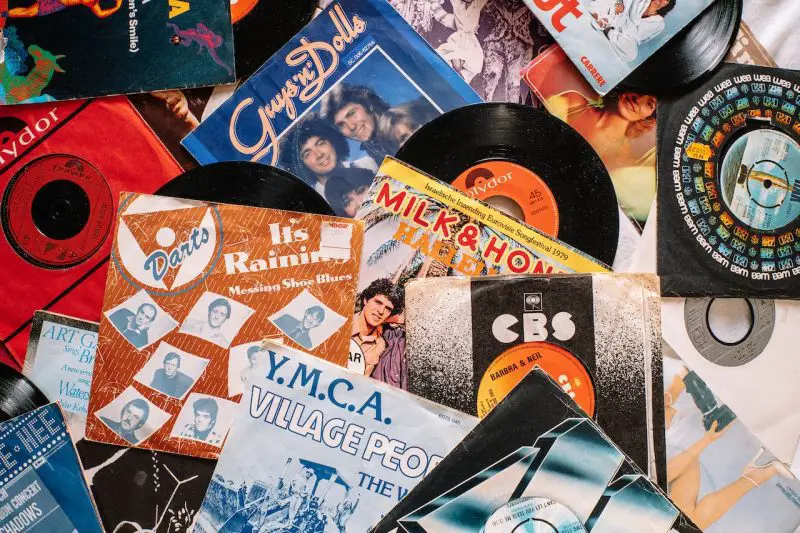A standard cardboard, long-playing (LP) vinyl record cover is 12.375 inches (31.43 cm) square.
Since the middle of the 1990s, though, music products have been packaged and distributed in compact disc (CD) formats. A typical compact disc (CD) cover is 4.72 inches square.
Today, music is commonly packaged and distributed as digital downloads.
Vinyl Record Sizes
Vinyl record sizes vary based on how much music is stored on the disk surface. Vinyl records come in 3 standard sizes: 7-inch (18 cm), 10-inch (25 cm), and 12-inch (30 cm) sizes.
7-inch
The standard 7-inch single is the smallest record size with a base speed of 45 rpm (revolutions per minute), designed to be less expensive than its counterparts. However, a 7-inch disk typically allows for only 5 minutes of music playing time.
It was considered the perfect method, though, for distributing exclusive, extended-cut versions of songs.
10-inch
The 10-inch size is the most uncommon, typically found in 78-rpm records pressed before the 1950s. With the highest rpm, they offered increased sound quality. However, since they also required the record to spin faster, they didn’t last very long.
The late 1950s phased the 10-inch record out with the popularity of vinyl LPs and other 12-inch records. The extra grooves provided by LPs and other 12-inch records meant more music capacity.
Today, 10-inch records are collectors’ items. Some of the most prized, vintage 10-inch records are from 1948 to 1956, cut by jazz artists on labels such as Clef, Savoy, Prestige, and Blue Note.
12-inch
The 12-inch album is the largest record size. Generally, it can store up to 22 minutes of music on each side, or up to 45 minutes of total playing time back to back.
Disc jockeys (DJs) tend to use singles of larger record sizes like the 12-inch size because the extra space means extra quality and more opportunities for creative mixing.

Vinyl Record Speeds
Just as there are 3 vinyl record sizes, there are also 3 record speeds. They are measured in revolutions per minute (rpm), which is the number of times a record is spun within a minute. The 3 record speeds are 45 rpm, 33 rpm, and 78 rpm.
Generally, although faster speeds have higher quality audio, they have less amount of play. With the record spinning faster, it has less time and space to store audio.
On the other hand, slower speeds lose some sound quality but are able to store more audio with slower spins.
45 rpm
This is the most common speed for 7-inch records. Apparently, audiophiles have agreed that they could compromise sound quality for more music to listen to with 45-rpm record speeds.
33 rpm
This is the standard speed for most LPs and other 12-inch records. It can push storage to its limits more than other speeds can.
The 33-rpm record was launched in 1948 by Columbia Records. It soon became popular because it could play entire classic performances without your having to flip the disk.
78 rpm
Before 1948, music listeners used radio instead of their own records, and radio stations used 78-rpm records. Why buy your own expensive record when you could listen to the radio which plays them for free and at a higher sound quality?
However, 78-rpm records held less music and tended to be fragile. When the 33- rpm record came out, both radio stations and listeners flocked to the lower-rpm but higher-storage record.
Today, the 78-rpm speed is so rare, that it’s even difficult to find record players that can play vinyl records at 78 rpm!
Vinyl Record Covers and Sleeves
Vinyl record covers or jackets are sometimes interchangeably used with vinyl record sleeves, but they are different.
Covers or jackets are the “outerwear”, usually made of cardboard. Sleeves are the “innerwear” and actually hold the record, usually made of paper. Sleeves are also called “dust sleeves” or “album liners”.
How Do Vinyl Records Work?
A vinyl record works by spinning on the turntable or record player. A stylus on the record player moves through the grooves imprinted on the disk and “reads” the electric signal they generate.
Record players convert these vibrations generated by the grooves when the record is played into analog sound waves. These sound waves are transferred to an amplifier and then conducted through speakers, to come out as musical sounds.
Analog transmitters emit a continuous signal that varies depending on the needle pressure on the grooves. The varying part of the signal — called by audiophiles the “warmth” or “natural sound” of a vinyl record — also represents how intact the grooves are.
Every time the record spins, your turntable reads and decodes the continuous spiral grooves, starting at the edge of the disk and spiraling inward in real time. This results in music pumping from the vinyl record disk. The less you play the record, the better it sounds, because there is less wear and tear on the grooves.
Today, music is commonly streamed through MP3s and other digital formats through digital transmission. However, to untrained ears, there is not much difference between the quality of sound from vinyl records and from digital devices, assuming the vinyl records have no dirt, grease, scratches, and other deformities.
However, a computer or CD player can never replicate the aesthetics and nostalgia that playing music from a vinyl record player can provide.
FAQ
The size of a standard vinyl record cover is 12 inches by 12 inches (30.48 cm by 30.48 cm). This is the size of a typical LP (long-playing) record cover.
Yes, there are other sizes of vinyl record covers. For example, a 7-inch single record usually comes with a 7-inch by 7-inch (17.78 cm by 17.78 cm) cover. There are also smaller sizes for some special edition releases, and larger sizes for box sets.
The 12-inch size of vinyl record covers was standardized in the late 1940s when Columbia Records introduced the 33 1/3 RPM LP record format. This size was chosen because it allowed for more detailed artwork and liner notes, which was important for promoting the music and attracting buyers.
Yes, vinyl record covers can be custom made in different sizes. However, it is important to ensure that the cover size fits the vinyl record format and packaging. Custom-made covers can be used for special edition releases, limited editions, or for unique packaging concepts.
- What Size is Regular Printer Paper? Quick Guide for Paper Dimensions - June 18, 2023
- What Size is My Monitor: A Comprehensive Guide - June 18, 2023
- How Big is Italy Compared to the US? A Concise Comparison - June 16, 2023

